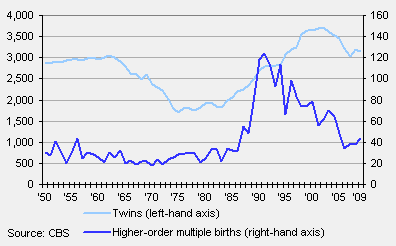Fewer multiple births

The number of multiple births has been in decline in the Netherlands since 2003. In recent years, usually only 1 egg cell is replaced in the uterus during in vitro fertilisation, resulting in a considerable reduction in twin births.
Peak twin births in 2002
Approximately 3,200 multiple births were registered in the Netherlands in 2009, mainly twin births. Only 44 were triplets and higher-order multiple births. With 3.7 thousand, the number of twin births reached a record in 2002. Subsequently, the number declined. With 124, the highest number of triplets and higher-order multiple births was recorded in 1991.
Twins, triplets and higher-order multiple births

IVF method caused higher number of multiple births
The proportion of multiple births has risen substantially since the mid-1970s: from 10 per 1,000 births in 1975 to 19 per 1,000 in 2002. This is predominantly caused by in vitro fertilisation (IVF), a technique which was introduced approximately thirty years ago and has become increasingly popular. The fact that multiple births occur more commonly in older women only plays a modest role. The total number of births in 2009 was only just above the mid-1970s.
Multiple births per 1,000 births

Fewer egg cells replaced
Initially, 4 or 5 fertilised egg cells were replaced in the uterus during IVF treatment to enhance the chance of success. This led to a noticeable increase in the number of multiple births in the 1980s and 90s. Subsequently, replacing no more than 2 egg cells became common practice and as a result the number of triple and higher-order multiple births was reduced, but the number of twin births continued to grow.
In recent years, only 1 egg cell was replaced and the number of IVF twins dropped accordingly. Between 2003 and 2009, the proportion of IVF twin births dropped from 22 to 15 percent. The share of singleton IVF births in the total number of singleton births, on the other hand, increased from 1.5 to 2.2 percent.
Number of IVF-induced twin births

Elma Wobma and Joop Garssen